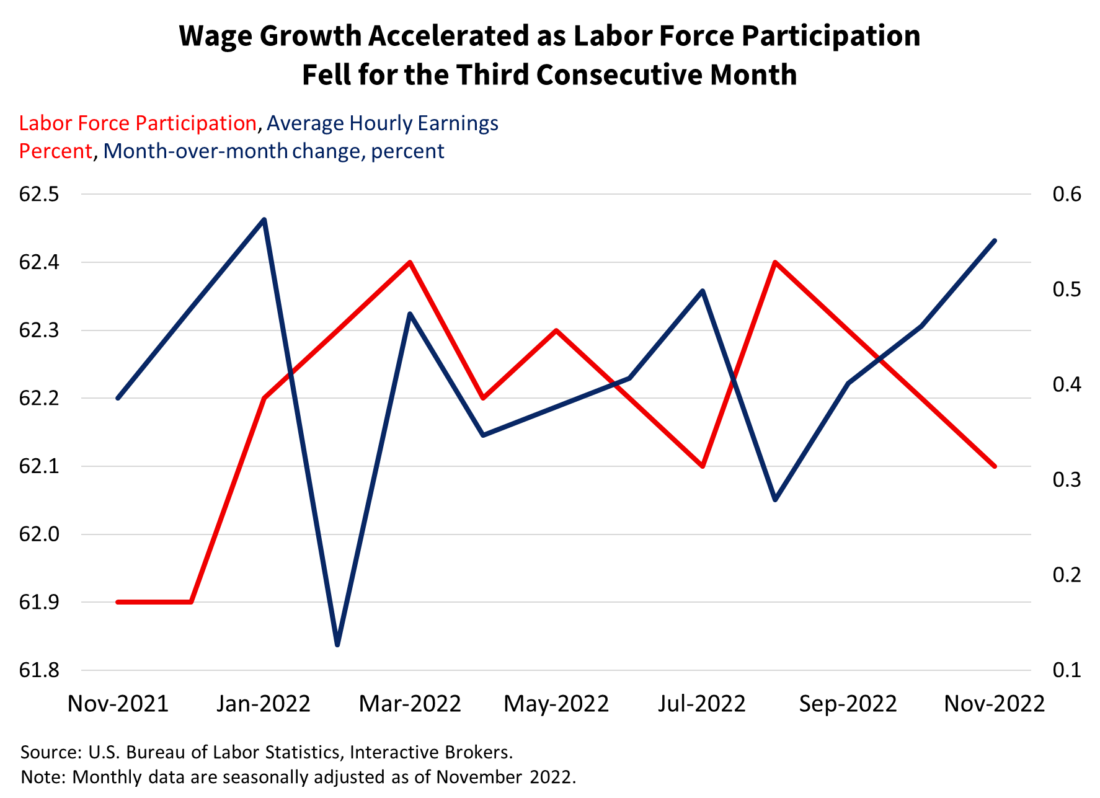Economic data continues to bruise investor sentiment with a one-two punch of weakening manufacturing activity and a persistently tight labor market. After ISM PMI data reversed a market rally yesterday, equity prices are plummeting further today in response to this morning’s news that wage growth accelerated significantly in November while the economy added 263,000 jobs, blowing past the 200,000 consensus estimate but trailing the 284,000 jobs added in October. In another troubling development, the already low labor participation rate continued to decline.
As equity prices dropped more than 1% this morning, the dollar exchange rate increased a half a percentage point and yields climbed across the curve in a bear-flattening formation in reaction to the Labor Department’s jobs report.
Investors are focusing on persistent inflation and fears that the Federal Reserve’s (the Fed) aggressive rate hiking and balance sheet reduction will spark a recession, so today’s news that private-sector hourly earnings grew 0.6%, which easily blew past the expected increase of 0.3%, is a hurtful interception during what has been an impressive comeback late in the fourth quarter. It is the third consecutive month of wage acceleration and comes just two days after Fed Chairman Jerome Powell implied that labor market weakness is required to tame decades-high inflation. Powell also discussed how the low labor participation rate, or the portion of working age individuals that is either working or seeking work, is contributing to wage pressure.
Against that backdrop, today’s news that labor force participation declined for the third consecutive month and hit 62.1, a 10-basis point month-over-month drop, is another blow to investor sentiment. The level is a considerable 1.3 percentage points below the February 2020 pre-pandemic level. In a commentary yesterday, I discussed how the ISM PMI is indicating that manufacturing is contracting. Nevertheless, businesses still need workers, but fewer workers want to participate in the labor market and that’s causing wages to continue climbing. Unfortunately for the Fed, wage growth is the most resistant form of inflation and the economy faces the threat of an upward wage and price spiral that could require continued monetary tightening to cool off.

During a week of heavy cross-currents on the economic calendar, today’s report offers more of the same: some strength and some weakness. After remaining flat for five consecutive months, the average hourly work week fell to 34.4 hours, the lowest level since the height of the pandemic in April 2020, signaling slowing demand as employers cut hours. The unemployment rate stayed flat at 3.7%, however, implying that unemployed workers that want to work can find jobs pretty easily. This combination of trends is negative for productivity, as a shrinking labor force implies that the economy is not operating at full capacity, bad for the supply-side of the economy and for earnings prospects.
The jobs report is based on two surveys—the establishment survey and the household survey. When looking at the less scrutinized household survey, which is compiled by calling households to inquire about employment status, the economy actually lost 138,000 jobs in November, the second consecutive monthly decline by that measure. Unlike the household survey, some economists speculate that the establishment survey overstates the number of jobs in the economy. A person with two jobs counts as two in the establishment survey but only one in the household survey. Have some workers been forced to have two jobs to cope with the rising cost of living, higher financing costs and a sharp contraction in fiscal spending? Absolutely. How much does it move the needle, however, is unclear.
November’s payroll job gains were led by the leisure and hospitality, education and health services, government, other services, and construction sectors, with each adding 88,000, 82,000, 42,000, 24,000 and 20,000 jobs, respectively. Gains were broad based, with almost all eleven major sectors contributing to gains, albeit more modestly. The trade, transportation and utilities sector was the exception, losing 49,000 jobs led by the retail and transportation and warehousing sub-sectors, each shedding 30,000 and 15,000 jobs.
The plummeting sentiment illustrates how quickly investors’ outlook can change. In late November, investors grew increasingly optimistic that the Fed was ready to significantly slow its pace of rate hikes and the anticipated terminal rate—or the final rate to be implemented to cool off the economy—was below 5%. In response to this morning’s labor market report, investors are now increasingly anticipating a terminal rate above 5%. In addition to concerns over declining demand, today’s report reminds investors not to overly rejoice in declaring an early victory over inflation. Especially when the Cleveland Fed’s Inflation Nowcast is forecasting inflation, as measured by the next CPI reading, to show a fierce acceleration from October to November.
Meanwhile, in Canada, the employment gain was 10,100 in November, much lower than the 108,300 jobs gained in October and slightly better than expectations of 5,000. The unemployment rate fell to 5.1%, better than expectations for a rise to 5.3%.
Disclosure: Interactive Brokers
Information posted on IBKR Campus that is provided by third-parties does NOT constitute a recommendation that you should contract for the services of that third party. Third-party participants who contribute to IBKR Campus are independent of Interactive Brokers and Interactive Brokers does not make any representations or warranties concerning the services offered, their past or future performance, or the accuracy of the information provided by the third party. Past performance is no guarantee of future results.
This material is from IBKR Macroeconomics and is being posted with its permission. The views expressed in this material are solely those of the author and/or IBKR Macroeconomics and Interactive Brokers is not endorsing or recommending any investment or trading discussed in the material. This material is not and should not be construed as an offer to buy or sell any security. It should not be construed as research or investment advice or a recommendation to buy, sell or hold any security or commodity. This material does not and is not intended to take into account the particular financial conditions, investment objectives or requirements of individual customers. Before acting on this material, you should consider whether it is suitable for your particular circumstances and, as necessary, seek professional advice.





















